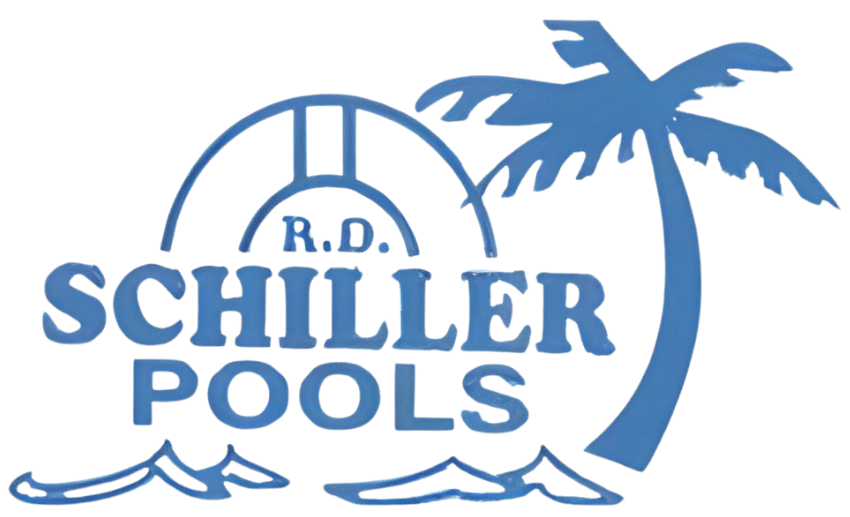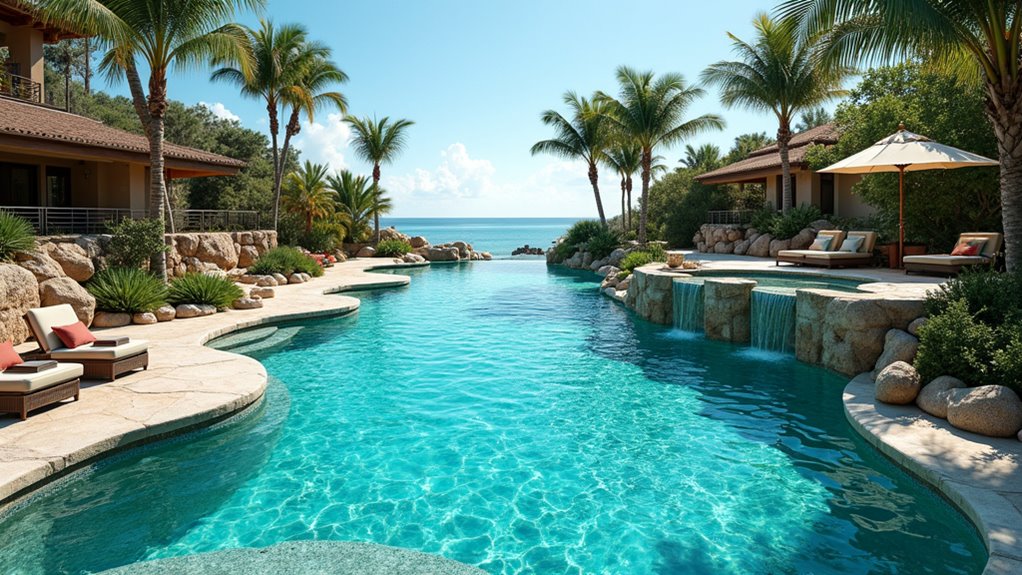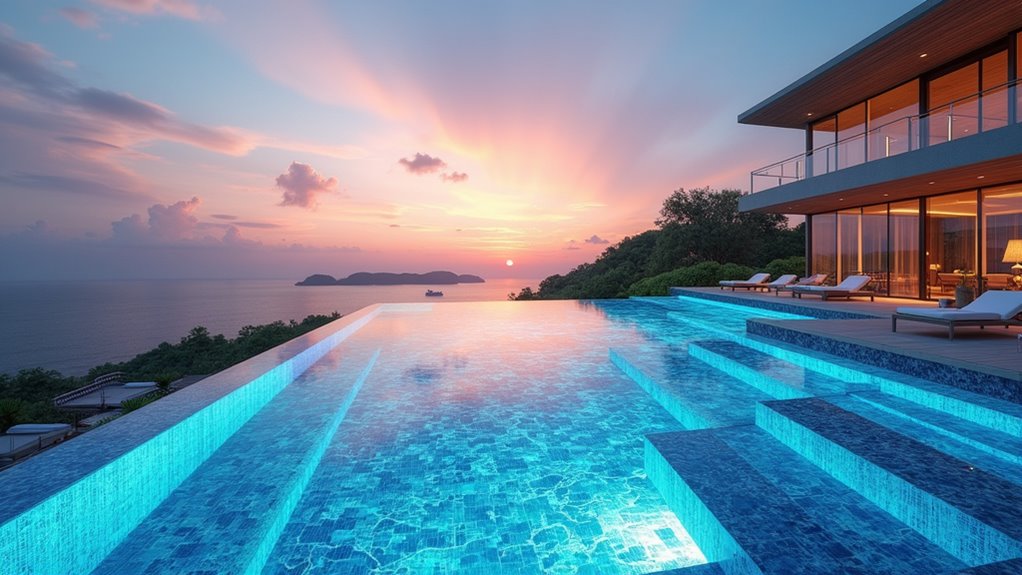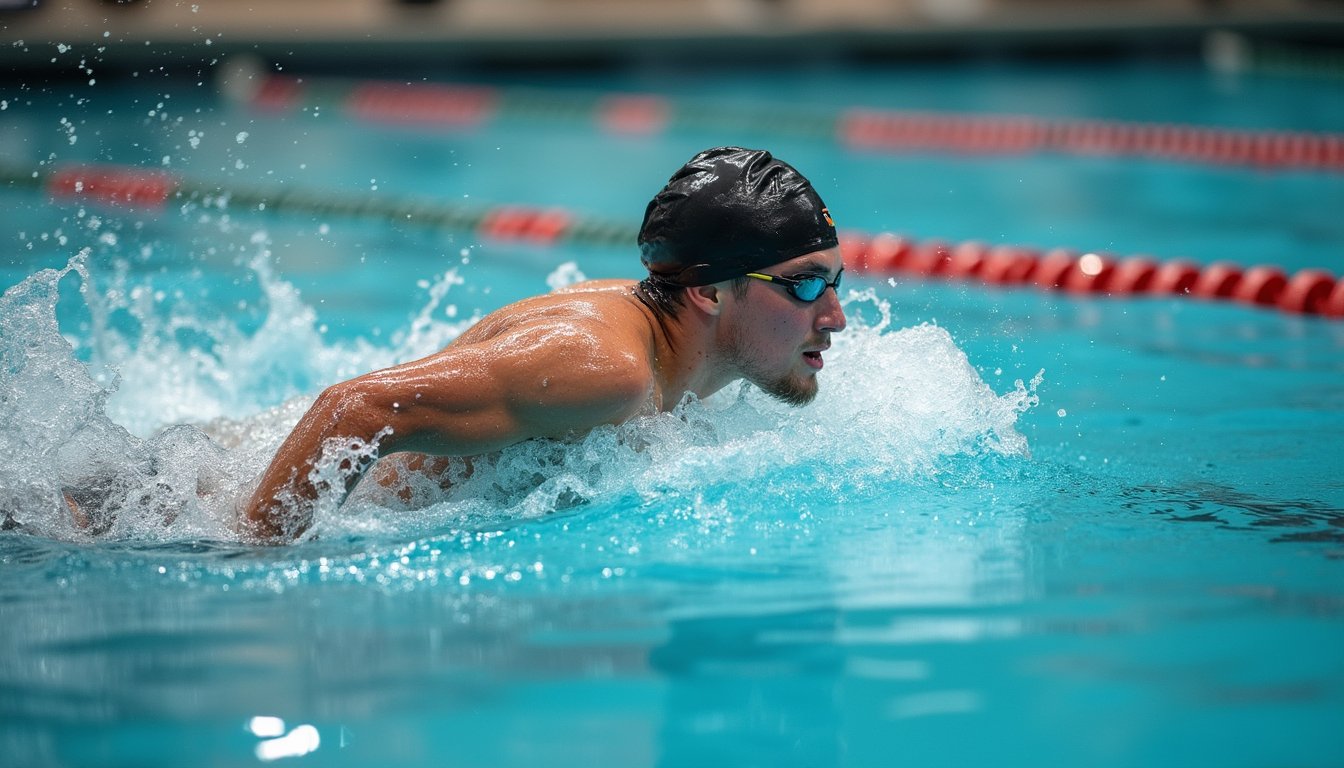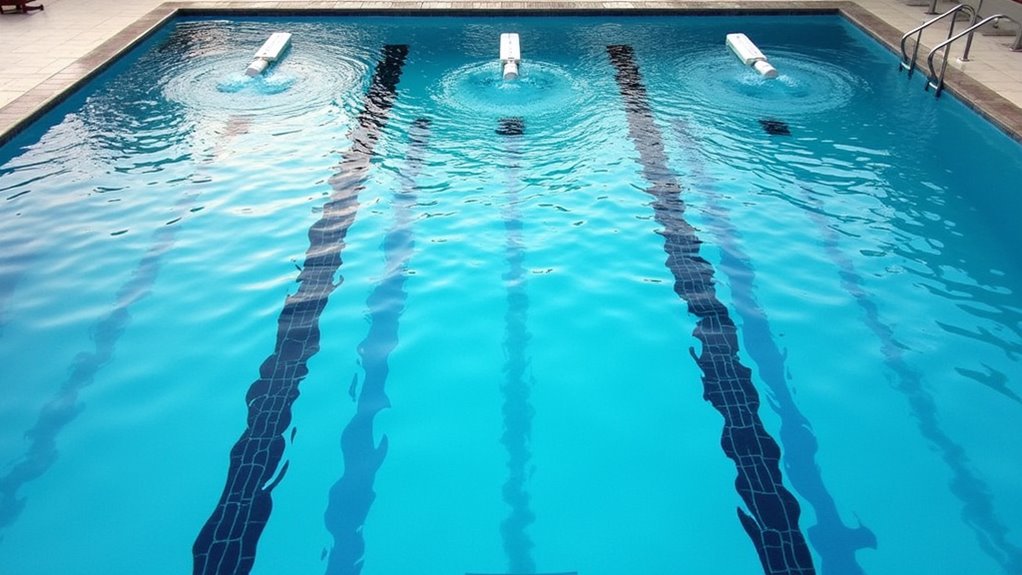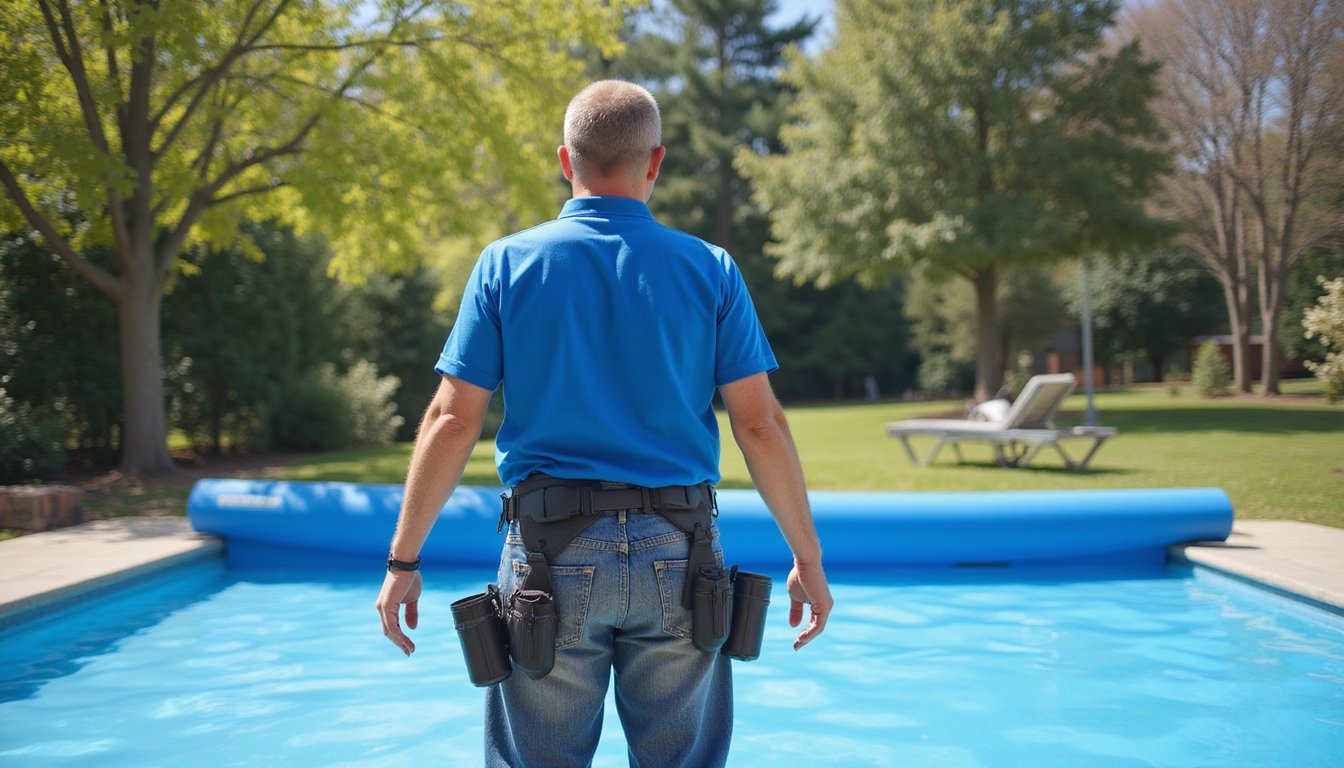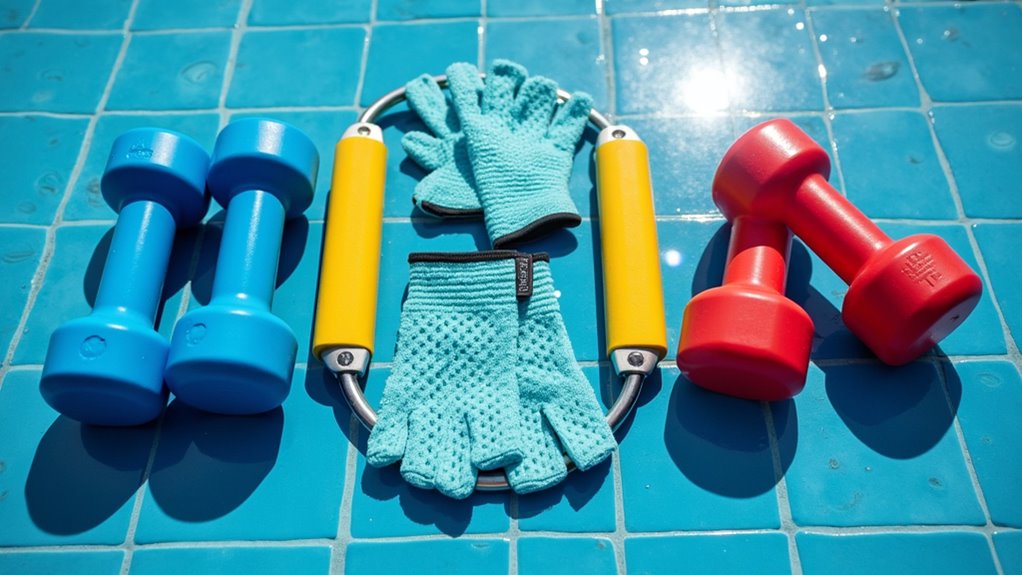A true leisure pool goes beyond basic swimming functionality. You’ll find sophisticated architectural elements merged with therapeutic features like hydrotherapy jets, ergonomic seating, and multi-zone designs. It incorporates advanced safety systems, ADA-compliant access points, and high-performance materials like composite armor reinforcement. Your leisure pool should deliver a seamless blend of wellness areas, family recreation spaces, and aesthetic integration with surroundings. Uncover how these essential elements work together to create the paramount aquatic sanctuary.
The Evolution of Modern Pool Design

The transformation of modern pool design represents a revolutionary shift from traditional rectangular formats to sophisticated architectural statements. You’ll find today’s pools serve as customized design statements that seamlessly integrate with their surroundings through distinctive scenery blending techniques. The incorporation of natural stone finishes has become increasingly popular for creating an organic, eco-conscious aesthetic.
Modern pools have evolved to embrace sleek minimalism with clean lines and geometric patterns, while also incorporating curved elements that create visual flow. The addition of Baja shelves enhances the functionality and aesthetic appeal of rectangular designs. Contemporary designs feature curved corners that add elegance while complementing minimalist outdoor spaces. The introduction of infinity edges and perimeter overflow systems has redefined luxury aesthetics, creating mirror-like surfaces that amplify the overall design impact.
This evolution extends beyond mere appearances, incorporating smart technology and automated systems that allow precise control over lighting, heating, and maintenance. You’re now able to manage these features through smartphone apps, making pool ownership more convenient and sophisticated than ever before.
Essential Components of Leisure Pool Architecture
Modern leisure pool architecture demands careful integration of essential components that work in harmony to create safe, functional, and aesthetically pleasing aquatic environments. Efficient pool pump systems drive continuous water circulation, ensuring optimal filtration and cleanliness throughout your pool. Marine-grade aluminum fencing provides robust perimeter security while maintaining an elegant aesthetic. You’ll find that successful leisure pool designs incorporate automated maintenance systems for water quality control alongside integrated entertainment systems that transform your pool into a versatile recreational space. Strategic lighting and expertly placed water features enhance the overall architectural appeal while creating a tranquil atmosphere.
- Your pool’s foundation starts with premium copings and decking materials, ensuring durability while providing essential safety features
- Advanced underwater lighting systems create ambiance while enhancing visibility for evening swimming
- Smart technology integration allows you to control everything from water temperature to hydromassage jets through your mobile device
These elements combine to deliver a sophisticated aquatic experience that balances luxury with practicality, making your leisure pool both a functional investment and an architectural showpiece.
Seamless Entry and Accessibility Features

While designing your leisure pool, integrating seamless entry and accessibility features becomes paramount for guaranteeing universal access and ADA compliance. You’ll need to ponder specific requirements based on your pool’s perimeter length, pools over 300 linear feet require two accessible entry methods, while smaller ones need one. Recent research shows that priority populations benefit significantly from accessible pool facilities. These entry solutions promote enhanced physical well-being through regular aquatic activities. All routes connecting accessible elements must maintain a minimum width of 36 inches.
| Entry Type | Specifications | User Benefits |
|---|---|---|
| Pool Lifts | 300lb capacity, 16-19″ seat height | Independent transfers |
| Sloped Entries | 1:12 max gradient, handrails | Self-guided access |
| Transfer Systems | 48″ max depth, 36″ clearance | Multiple entry options |
For ideal accessibility, you’ll want to position different entry types on separate pool walls. Guarantee your primary entry method allows for independent user operations, whether it’s a lift system or zero-depth entry. All features must comply with specific technical standards while maintaining seamless integration with your overall design aesthetic.
Therapeutic Elements and Wellness Zones
Strategic placement of hydrotherapy jets and ergonomic seats allows you to experience therapeutic massage while maintaining ideal 91-92°F water temperatures in designated wellness zones. These specialized features help reduce muscle spasms and decrease localized inflammation through targeted hydrotherapy applications. Modern leisure pools incorporate features that support aquatic exercise training, which studies show can match land-based programs for rehabilitation outcomes. You’ll find stress-relief features like cascading waterfalls and bubble benches that stimulate endorphin release and promote muscle relaxation through targeted water pressure. The pool’s deep relaxation zones incorporate specialized floating areas where you can practice aquatic meditation techniques while benefiting from the water’s natural buoyancy and therapeutic properties. Drawing from ancient practices, these therapeutic elements follow a tradition of water-based healing that dates back to the earliest civilizations.
Hydrotherapy Jets and Seats
Integrated throughout leisure pools, hydrotherapy jets and specialized seating zones create targeted therapeutic environments that combine precise water pressure with ergonomic design. You’ll find strategically positioned jets delivering massage effects through concentrated water streams, while thermal contrast therapy zones optimize circulation benefits through temperature variations between 38°C and 20°C. The incorporation of Japanese cypress materials, traditionally used in onsen pools, adds natural therapeutic properties to modern hydrotherapy installations. Similar to the ancient Roman baths, these therapeutic water features have historically proven benefits for treating various ailments and promoting wellness. The buoyancy of water creates a non-weight bearing environment that significantly reduces joint stress while enabling therapeutic movement.
- Multi-functional therapy stations incorporate swan-neck fountains, air loungers, and vitality zones with targeted jet configurations for muscle relaxation
- Ergonomic seating features precise angles and contours, boosted by underwater resistance jets that create destabilizing currents for strength training
- Air tub systems integrate with standard hydrotherapy jets to provide dual-action therapy, combining bubbling effects with focused pressure points
These integrated systems work together to enhance lymphatic drainage, improve circulation, and deliver extensive therapeutic benefits while maintaining design sophistication.
Stress-Relief Water Features
Modern leisure pools incorporate sophisticated water features that deliver powerful stress-relief benefits through carefully engineered therapeutic elements and wellness zones. You’ll experience profound relaxation through meditation-inducing waterfalls that alter your brainwave patterns, shifting your mind from active to meditative states. Restorative water acoustics create natural white noise, effectively masking unwanted environmental sounds while promoting mental clarity and improved sleep patterns.
Strategic placement of cascades, fountains, and bubblers transforms your pool into a therapeutic sanctuary. These features don’t just elevate aesthetics; they serve as natural humidifiers and oxygenators, improving both water quality and ambient conditions. You’ll find spillover spas and tiered waterfalls particularly effective for achieving deep relaxation states, while shallow-floor bubblers provide adjustable sensory elements that contribute to your overall wellness experience.
Deep Relaxation Zones
Transforming traditional pool spaces into therapeutic sanctuaries, deep relaxation zones combine precise temperature control systems with specialized design elements to deliver ideal wellness benefits. You’ll find custom cooling and heating configurations maintaining essential temperatures between 92-96°F, specifically designed for muscle relaxation and improved circulation.
Water depth versatility plays a vital role in these therapeutic environments, featuring:
- Strategic depths ranging from 3.5 to 6.0 feet for vertical therapy sessions
- Specialized benching systems positioned at varying levels for staged relaxation
- Multi-depth zones accommodating different therapeutic techniques and mobility needs
Your relaxation experience is heightened through thoughtfully integrated features like flush deck gutters, temperature-controlled jets, and therapeutic current systems. These elements work in harmony with mood-enhancing lighting and soothing water features to create the paramount wellness sanctuary.
Family-Friendly Safety Considerations
Safety remains paramount in leisure pool design, with multiple integrated systems working together to protect families and prevent accidents. You’ll need to implement comprehensive supervised access protocols through strategically positioned 5-foot fencing with self-closing gates and reliable locking mechanisms. Visual monitoring solutions must include unobstructed sightlines for constant surveillance while maintaining effective barriers.
Your safety infrastructure should incorporate pool alarms, non-slip deck surfaces, and properly installed pool covers that meet current safety standards. You’ll want to position depth markers clearly and guarantee all gates open away from the pool area. Consider installing multiple security layers, including perimeter fencing and interior barriers, creating essential obstacles that prevent unauthorized access. Remember to keep the pool area free of toys and other attractive items that might tempt young children to enter unsupervised.
Advanced Construction Materials and Methods

Your pool’s structural integrity begins with Composite Armour™ Reinforcement Technology, which combines DuPont™ Kevlar, carbon fiber, and basalt fiber in a proprietary formulation that delivers superior protection against ground movement and structural stress. The advanced surface technology features AQUAGUARD®X gelcoat, maintaining the pool’s structural integrity indefinitely while resisting UV degradation and chemical damage. You’ll benefit from a multi-layer vinyl ester resin system that comprises 70% of the shell composition, preventing osmosis penetration and ensuring long-term durability.
Composite Core Technology Advancements
The latest advancements in composite core technology have revolutionized leisure pool construction through novel ceramic microsphere integration and aerospace-derived materials. You’ll find cutting-edge vinyl ester resin systems combined with ceramic microspheres that withstand pressures up to 10,000 psi while preventing osmosis and chemical degradation.
- Advanced multi-layer construction featuring NASA-developed waterproof ceramic technology
- Carbon fiber reinforcement derived from aerospace applications for superior structural integrity
- Maxi-Rib foundation support system enabling efficient above-ground installations
The integration of these components creates a pool shell that’s both lightweight and incredibly durable. The controlled factory environment guarantees precise layering of materials, from the ceramic core to the UV-resistant external coating. This creative construction method delivers superior performance while reducing installation time and maintenance requirements compared to traditional pool manufacturing techniques.
Premium Surface Protection Systems
Modern premium surface protection systems integrate multi-layered PVC membrane technology with advanced polymer composites to deliver exceptional durability and safety in leisure pool environments. You’ll find 60-mil thick PVC-P reinforced membranes with polyester mesh providing amplified mechanical resistance and dimensional stability for durable waterproofing membranes.
The system’s chemical resistance features include specialized surface varnish treatments that protect against UV rays, microorganisms, and chlorine exposure. You’re getting thorough protection through antimicrobial agents and ultra-violet inhibitors that prevent premature aging and bacterial growth. The advanced construction incorporates custom welding capabilities for installation over diverse substrates, while the exclusive topcoat safeguards against stains and wear. This engineered approach guarantees your leisure pool maintains its integrity and appearance, even under intense chemical and environmental exposure.
Aesthetic Integration With Natural Surroundings
Successful leisure pool designs hinge on seamless integration with their natural surroundings, requiring careful consideration of existing environment elements, terrain features, and architectural components. To achieve harmony in the outdoor setting, you’ll need to carefully align pool geometry with existing contours while preserving mature vegetation and natural drainage patterns.
Creating a naturally integrated pool design transforms your backyard into a harmonious outdoor sanctuary that celebrates its existing landscape features.
- Select materials that mirror your existing hardscape elements, using consistent pavers, coping, and decking to create visual cohesion between pool areas and surrounding features
- Incorporate water features and natural stone elements that complement your terrain’s unique characteristics, especially in challenging sloped or rocky outdoor settings
- Choose native plant species that blend seamlessly with existing garden beds while guaranteeing low-maintenance, non-shedding varieties near pool edges
This environmental preservation approach ensures your leisure pool becomes an organic extension of your outdoor setting rather than an isolated feature.
Multi-Purpose Aquatic Zones and Activities
Strategic zoning within leisure pools creates distinct activity areas that optimize functionality while maintaining seamless flow between spaces. You’ll find custom activity programming seamlessly integrated through specialized zones, from zero-entry beaches to therapeutic areas. Interactive entertainment elements bolster user engagement across multiple depths and temperature ranges.
| Zone Type | Depth Range | Primary Activities |
|---|---|---|
| Beach Entry | 0-3.5 ft | Casual wading, children’s play |
| Current Channel | 3.5-4.5 ft | Floating, walking |
| Activity Pool | 3.5-5.0 ft | General recreation |
| Therapy Zone | 3.5-6.0 ft | Exercise, rehabilitation |
| Entertainment Area | 3.0-4.0 ft | Social gathering, relaxation |
Your leisure pool experience integrates multiple temperature zones, from standard 84-86°F recreation areas to 92°F therapy sections, ensuring comfort across all activities while maintaining efficient space utilization within the 7,000-square-foot aquatic environment.
Frequently Asked Questions
How Long Does It Take to Install a Complete Leisure Pool System?
Your leisure pool installation timeline typically ranges from 3-12 weeks, depending on the pool type you’ve selected. If you’re choosing fiberglass, you’ll see a pool construction timeline of 3-4 weeks, while concrete pools require 8-12 weeks. You’ll need to factor in site preparation, plumbing installation, equipment setup, and finishing work. Weather conditions, permit approvals, and site accessibility will directly impact your project’s completion schedule.
What Are the Typical Annual Maintenance Costs for Leisure Pools?
You’ll typically spend between $3,000 to $6,000 annually to maintain your leisure pool, with costs varying based on operational efficiency and energy consumption patterns. Your basic monthly services ($80-$150) cover chemical balancing and cleaning, while utilities add $800-$1,200 for electricity and $50-$250 for water annually. You’ll need to budget for equipment maintenance, including pump operations ($700-$1,300) and filter replacements ($1,500-$2,000) when necessary.
Can Leisure Pools Be Heated for Year-Round Use in Cold Climates?
Yes, you can achieve year-round accessibility in your leisure pool, even in cold climates, by installing the right heating system. For regions with significant seasonal temperature variation, you’ll need a gas heater or heat-cool pump system rated for sub-50°F operation. Your best option is often a high-BTU gas heater as your primary source, potentially combined with a heat-cool pump for moderate conditions. This setup guarantees consistent warmth regardless of outdoor temperatures.
Do Leisure Pools Require Special Permits or Zoning Approvals?
Yes, you’ll need to obtain residential construction permits and comply with local zoning regulations for your leisure pool installation. You must submit detailed plans, including setback requirements, pool barrier specifications, and engineering documentation. You’ll also need to meet specific building codes, secure proper inspections, and potentially obtain supplementary approvals if you’re in a Special Flood Hazard Area. Don’t skip these requirements, as violations can result in significant fines.
What Is the Average Lifespan of Leisure Pool Water Features and Equipment?
You’ll find that leisure pool equipment lifespan varies by component type and water quality management practices. Your pool pump should last 8-15 years, while heating systems typically function for 8-10 years. Filtration equipment needs replacement every 8-12 years. The pool’s structure itself varies considerably: vinyl liners last 6-15 years, fiberglass shells 25-30 years, and concrete pools over 50 years with proper maintenance and periodic resurfacing every decade.
